Elaine Morgan: my personal copy
Created | Updated Jul 22, 2005
This is the story of Elaine Morgan, a shy misfit who rose out of poverty to become a leading light in the fields
of drama, feminism, and science.
Elaine's mother, Olive, was the daughter of West Country1 immigrants, who had arrived in the
Welsh Valleys hoping to make their fortune from coal, and who had instead
sunk into desperate poverty and alcoholism. Olive had run the family home single-handedly from the age of ten.
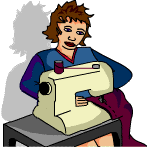
Elaine's father, Billy, was a talented metalwork craftsman who worked the pumps in the local colliery2 until the
1929 Depression brought years of unemployment. Returning later to work underground led to his death in
Elaine's late teens. Three generations of the family lived together in a terraced miners' cottage of the sort commonly seen in South Wales.
Olive was determined that Elaine should not follow in their footsteps. She gave her daughter every
encouragement with her education and never allowed her to lift a finger around the house. Elaine herself was a
sickly child, bad at making friends, but very bright. She spent much of her time writing stories about
things she had never experienced, such as birthday parties, and talking birds. She easily passed her 11+ exam and
got into grammar school3; from there she won a scholarship to read English at Oxford University4. On her first day at Oxford, she asked for directions to Lady Margaret Hall, the college where the female students were housed; her thick Welsh accent led to the assumption that she was applying for a job as a cleaner.
Coming from a deprived area, Elaine began to take an interest in socialism5, and joined the university's
Democratic Socialist Club, of which she later became Chairman; in this role, she invited illustrious political
thinkers to speak at their meetings. Keen on social reform, she also joined the Fabian Society, where several
people (including future Welsh cabinet minister James Griffiths) recommended that she try for a seat in Parliament. The idea appealed to her, but in the end she concluded that, since she
wanted children, it would be impossible: she took the view that motherhood and being an MP6 were
both full time jobs if they were to be done properly. It was a decision she was never to regret.
She returned home with a respectable honours degree and a keen interest in politics. She
attended a gathering at the Town Hall, to hear a local war hero speak about his experiences: Morien Morgan
had been to Spain to support the Communist cause against General Franco's dictatorship; he had been captured, and had raised the morale of
his comrades by organising classes in the prison camp, and by writing and circulating a newsheet. Elaine threw up
a question from the audience about whether Communism was really the answer, in the light of Stalin's recent behaviour in Russia. Morien parried the question, but was curious
about the questioner and some days later found out her address and paid her a visit. She answered the door in an
old smock. Her mother had taken a job in an armaments factory, so Elaine was cleaning out the grate. She had a
smudge of coal-dust on her cheek. Something about this melted Morien's heart and, instead of asking about her
politics, he asked her for a date.

The Second World War was in full swing. Elaine returned to adult education at the end of that summer, as a
lecturer for the Workers' Educational Association in Norfolk7. By coincidence, Morien had also been offered a
teaching post in Norfolk. Their relationship flourished and, after the war ended,
they married. Elaine was now a housewife and, for the first time in her life, she had to cook and clean. This did
not come naturally to her, and her eldest two sons spent their formative years believing that all food is brown. At one
period, they found themselves again short of cash, and they moved into a remote farmhouse
in the Radnorshire mountains, rent free to anyone who would live in it until
the farmer's 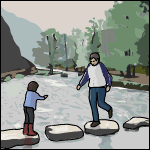 son was old enough to need it. Morien could only get back there at weekends from his lodgings in
son was old enough to need it. Morien could only get back there at weekends from his lodgings in
Abertillery, many miles away, where he was again working as a teacher.
Elaine found herself alone for long periods, with little to occupy her mind besides the toil of
maintaining a home which, though beautiful, had no running water, no electricity, no
neighbours and only a stone oven to cook in. To keep her mind active, she entered a writing competition in The
New Statesman8, and won it, and received a whole guinea9 to spend on her family. She entered  more competitions,
more competitions,
and won many of them. She then tried her hand at writing short stories for magazines, and they were published.
Mightily encouraged, she wrote a play, imagining that it would take the West End10 by storm--but the West End was
not interested. Her agent tried submitting it to BBC television. Few people had television sets then, and the
techniques for transmission were too primitive to attract many talented actors or writers. The BBC accepted her
piece straight away, and continued to commission and buy her work for the next 30 years. Elaine's talent for
writing drama developed alongside television's growth in popularity, and she came to win a plethora of awards,
including two Baftas, two Writers' Guild awards and a Prix Italia. Her most acclaimed work was a series aired in
1979, which dramatised Vera Brittain's war autobiography, Testament of Youth; for this, Elaine won the Writer
of the Year award from the Royal Television Society.
The extra income assured a comfortable life for her family. They were eventually able to buy a large
Victorian house, which had the luxuries of electricity and hot and cold running water. Their three boys had a
bedroom each. Morien, a skilled typist, had a private study, where he converted all of Elaine's handwritten
manuscripts into print. 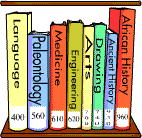
The disagreement that had brought the couple together continued, in many forms, throughout their
married life. Mealtimes were noisy
affairs, during which the whole family indulged in intellectual sparring over
matters such as politics, the origins of life, and whether or not flared trousers constituted sensible attire. Their
thirst for knowledge was reflected in the stuffed bookshelves present in every room, and in the flurry of
periodicals that fell through their letterbox. Elaine 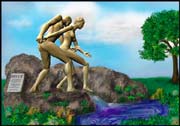 grew increasingly irritated by popular science writers of the day, such as Desmond Morris11 and Robert
grew increasingly irritated by popular science writers of the day, such as Desmond Morris11 and Robert
Ardrey12, who painted a male-centred picture of human evolution based on
the notion of a mighty hunter. She
found their explanations for the differences between humans and the other apes sketchy: man (they said) learned
to stand on two legs so that he could wield his spear whilst running after prey; man lost his body hair to keep him
cool whilst hunting; man developed breath control in order to be able to speak, so that hunts could be
discussed.
She sought alternative explanations for these differences. A brief mention in Morris's book led her to
discover an article written years earlier by Sir Alister Hardy13. The article hypothesised that the major differences
between humans and other apes might have come about from our having spent part of our evolution adapting to watery surroundings. It focused on the fact that, unlike apes, humans have a layer of fat under our skin and
minimal hair: the only other mammals with these characteristics are those which
spend a lot of time in the water. Hardy also suggested that the reason for our upright posture might be a result of
having had to keep our heads above water whilst wading. Elaine was intrigued, and looked for further
information. She was surprised to discover that many human characteristics had never been considered at all;
why, for example, can we swim so far, and why do we want to? Why are we the only apes to cry tears? And why is our
skin oily?
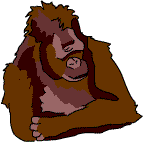
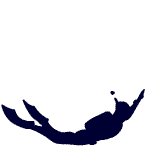
Elaine decided to write the book that she wanted to read, and so The Descent of Woman was born. In it, she
pointed out that human evolution is not driven by men, but by both sexes. Whilst promoting the aquatic theory,
she evened the scientific balance by focusing upon female evolutionary development. Such a standpoint, at a time when feminism was a major political issue, made the book an instant bestseller all
around the world. The newspapers were full of the story of the housewife who had taken the male scientific
establishment by storm. She was no longer known as 'Elaine', but as 'Morgan'. She was invited to interviews,
conferences and galas. A team of cameramen followed her and her youngest child on one of their two lecture
tours of America, where the pair were treated like stars.
Despite the public's enthusiasm, the aquatic hypothesis was dismissed by the
scientific community. The notion that humans might have come from the sea was considered ridiculous, and her
book's popularity among militant feminists gave 'Morgan' the image of a crank. Her lack of official scientific
training hindered her case further, but she stoically defended her work against the criticism it received, and took
on board the inconsistencies found in it. Ten years after her book was published, she wrote another
book, entitled The Aquatic Ape. This was a revision and extension of the ideas put forth by herself and Hardy,
and the hypothesis gathered acceptance among some well-known figures, including Desmond Morris. As a result
of this, the possibility of an aquatic human ancestry began to be mentioned in science documentaries and in some
university textbooks. Morgan was invited to speak at academic functions, in Britain and
abroad. It was when she was invited to address Oxford's Anthropological Society that she learned that
Douglas Adams was an admirer of her work. He had gone to great lengths to ensure that he could be not only
present at the conference, but seated in the chair next to hers during dinner; he persuaded his friend Richard
Dawkins14 to come with him. Knowing her sons to be great fans of the Hitchhiker series, Morgan was flattered by
this unexpected attention.
It has taken three decades, five books, and hundreds of conferences for Morgan and Hardy's vision of human
development to gain credence among the world's leading evolutionary scientists. Today, the Aquatic Ape Hypothesis is considered a viable one, which has raised questions to
which no related theory has yet found answers.
Morien died in 1997, three years before his wife received the extremely prestigious Letten F. Saugstad's prize for her contribution to scientific knowledge. At the time of this article's submission, she continues to live comfortably in her Victorian house in the South Wales Valleys, and has just completed her latest book. This one does not mention the water. It is entitled Pinker's List: The New Darwinists and the Left.
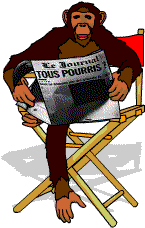
Footnotes
1. West Country: southwest England.2. Colliery: coal mine.
3. Grammar school: state-funded school for children with academic potential. (U.S.: 'elementary school'.)
4. Oxford University: situated in the South of England; one of Britain's two most highly respected universities.
5. Socialism: a co-operative system of government in which the means of production and distibution of goods is owned collectively by the populace.
6. MP: 'Member of Parliament'.
7. Norfolk: a county in the East of England.
8. The New Statesman: newspaper with a strong bias towards the political Left.
9. Guinea: obsolete British coin.
10.The West End: prosperous area of central London famed for its theatres.
11.Desmond Morris: zoologist, TV producer, and surrealist artist. Author of many books on human origins and animal behaviour.
12.Robert Ardrey: zoologist and Hollywood screenwriter; author of several major books on the origins of human behaviour.
13.Sir Alister Hardy: marine zoologist/naturalist and fine art painter; knighted for his scientific contribution to the fishing industry.
14.Richard Dawkins: evolutionary biologist. Author of several revolutionary books on the mechanisms of evolution.
References
Alister Hardy, 1960: 'Was Man More Aquatic in the Past?' in The New Scientist, pp. 642-5.Robert Ardrey, 1961: African Genesis; A Personal Investigation into the Animal Origins and Nature of Man. Simon and Schuster.
Desmond Morris, 1967: The Naked Ape : A Zoologist's Study of the Human Animal. Mcgraw Hill.
Desmond Morris, 1969: The Human Zoo. Mcgraw Hill.
Elaine Morgan, 1972: The Descent of Woman. Souvenir Press.
Elaine Morgan, 1982: The Aquatic Ape. Souvenir Press.
Elaine Morgan, 1990: The Scars of Evolution. Souvenir Press.
Machteld Roede, 1991: The Aquatic Ape: Fact or Fiction? Souvenir Press.
Elaine Morgan, 1994: The Descent of the Child. Souvenir Press.
Elaine Morgan in interview, 1996, 1997 and 2004.
Elaine Morgan, 2005: Pinker's List: The New Darwinists and the Left. Eildon Press.
